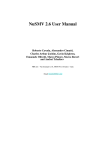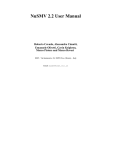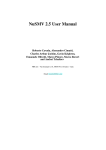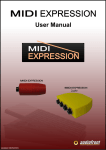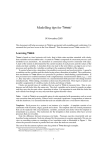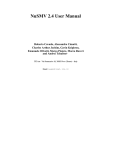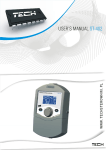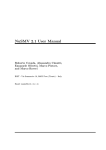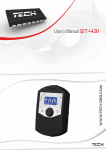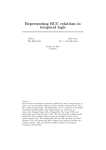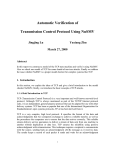Download System modelling
Transcript
Information Systems Analysis
Temporal Logic
and Timed Automata
(8)
System model verification in NuSMV
© Paweł Głuchowski, Wrocław University of Technology
version 2.3
Contents of the lecture
System modelling
●
●
●
●
Indirect modelling
Direct modelling
FAIRNESS constraints
Synchronous and asynchronous model of a system
●
●
Nondeterminism
Example: aircraft–intruder model
2
Contents of the lecture
Mistakes in system modelling
●
Different definitions of a variable
●
Recursive definition of a variable
●
●
Mutual dependency of variables
Contradictions in expressions INIT, INVAR and TRANS
3
Contents of the lecture
System verification
●
●
●
Possibilities
Property kinds to verify
Counting a minimal and maximal path of states
●
Example for the aircraft–intruder model
4
Contents of the lecture
Interactive work
●
●
●
●
●
●
Initial operations
Model verification
Model simulation
Restart and end of work
Executions of a script with operations
Description of operations performed by NuSMV
5
System modelling
●
●
●
●
Indirect modelling
Direct modelling
FAIRNESS constraints
Synchronous and asynchronous model of a system
●
●
Nondeterminism
Example: aircraft–intruder model
6
System modelling
Indirect modelling
Direct modelling
MODULE main
MODULE main
VAR
VAR
a : boolean;
b : 0..4;
ASSIGN
init(a):= TRUE;
next(a):= !a;
init(b):= {0,2,4};
next(b):= case
next(a) : {0,2,4};
!next(a) : {1,3};
esac;
a : boolean;
b : 0..4;
INIT
a = TRUE &
b in {0,2,4};
TRANS next(a) = !a;
TRANS next(b) in case
next(a) : {0,2,4};
!next(a) : {1,3};
esac;
CTLSPEC AG(a -> b in {0,2,4})
CTLSPEC AG(a -> b in {0,2,4})
INVARSPEC (!a -> b in {1,3})
INVARSPEC (!a -> b in {1,3})
7
System modelling
Indirect modelling
●
●
Behaviour of an automaton is defined by specifying initial and
next values of state variables.
Example:
ASSIGN
init(a):= TRUE;
next(a):= !a;
init(b):= {0,2,4};
next(b):= case
next(a) : {0,2,4};
!next(a) : {1,3};
esac;
●
Operator init defines the initial value of a variable.
●
Operator next defines the value of a variable in the next state.
8
System modelling
Indirect modelling
●
If the initial value of a variable is not given, it will get any value
from its range of values.
(There exists at least 1 initial state.)
●
If the next value of a variable is not given, it will get any value
from its range of values.
(There exists at least 1 next state for every state.)
Remark
●
Every model defined indirectly can be defined directly.
●
Not every model defined directly can be defined indirectly.
9
System modelling
Direct modelling
●
Behaviour of an automaton is defined by logic expressions.
●
Logic expressions express:
●
●
initial states,
●
reachable states,
●
transitions between states.
Results of lack of expressions or of their mutual contradiction:
●
an empty set of initial states,
●
unreachable states,
●
lack of reachable states.
10
System modelling
Direct modelling
●
Specification of initial values of variables:
INIT logic_expression
●
The expression given after INIT describes initial values of variables.
●
Example of specification of values of variables a and b:
INIT a = TRUE &
b in {0,2,4}
●
●
●
If the initial value of a variable is not given,
it will get any value from its range of values.
If an untrue expression is given, then there are no initial states
(model verification may be incorrect).
Using the operator next is not allowed.
11
System modelling
Direct modelling
●
Specification of reachable states by state invariants:
INVAR logic_expression
●
●
The expression given after INVAR describes the values of variables,
that characterise every state.
Example of specification of values of variables a and b:
INVAR a=TRUE | a=FALSE
INVAR !a -> b in {1,3}
●
If an untrue expression is given, then there are no reachable
states (model verification may be incorrect).
●
Invariant definitions are not mandatory.
●
Using the operator next is not allowed.
12
System modelling
Direct modelling
●
Specification of allowed transitions between states:
TRANS logic_expression
●
●
The expression given after TRANS describes allowed values of variables
in the next state.
Example of specification of next values of variables a and b:
TRANS next(a) = !a;
TRANS next(b) in case
next(a) : {0,2,4};
!next(a) : {1,3};
esac;
●
If an untrue expression is given, then there may be no next
state (model verification may be incorrect).
13
System modelling
Direct modelling
●
INVAR or INIT combined with TRANS?
●
1st way – invariantly a = 1:
INVAR a=1
●
2nd way – in the initial and every following state a = 1:
INIT a=1
TRANS next(a)=1
●
The effect seems to be the same, but the 1st way is more effective.
–
In this situation it is recommended to use an invariant.
14
System modelling
FAIRNESS constraints
●
Constraint JUSTICE expression
●
●
Alternatively: FAIRNESS expression
Model verification consists of these paths only, where the expression is
true infinitely many times, e.g.:
VAR a : boolean;
JUSTICE !a
●
It corresponds to the formula AG(AF((a))).
●
Using the operator next in the expression is not allowed.
15
System modelling
FAIRNESS constraints
●
Constraint COMPASSION (expression1,expression2)
●
Model verification consists of these paths only, where:
–
if the expression1 is true infinitely many times,
then the expression2 is also true infinitely many times
on the same paths, e.g.:
VAR a : boolean;
b : boolean;
COMPASSION (!a,!b)
–
●
It corresponds to the formula AG(AG(AF((a))) AG(AF((b)))).
●
Using the operator next in the expressions is not allowed.
●
NuSMV does not fully support the COMPASSION yet.
16
System modelling
Synchronous and asynchronous model of a system
●
In the synchronous model, in one step:
●
a change of state of every module takes place in parallel
–
●
a simultaneous change of values of variables (according to the
specification) in every module.
In the asynchronous model, in one step:
●
a change of state of one module (process) takes place
–
a change of values of variables (according to the specification)
in one module.
●
Sequence of processes is random.
●
Variables of other processes remain unchanged in this step.
●
Processes are nod used now (they are “deprecated”).
17
System modelling
Nondeterminism
●
Definition of a variable requires to give a set of its values, e.g.:
VAR
a : 0..10;
b : {s1, s2, s3};
●
●
If no instruction assigns any value to a variable,
then the variable gets a random value of the range of its values.
If an instruction assigns a subset of a variable's set of values to
the variable, then the variable gets a random value of this
subset, e.g.:
a := {s1,s3}
18
System modelling
Example: aircraft–intruder model
●
Description of the situation:
●
A runway intersects a taxiway.
●
An aircraft begins moving before the intersection, accelerating.
●
The aircraft, accelerating, reaches the V1 velocity (after time 6..8),
and then takes off (after time 1..3).
●
The take-off of the aircraft may happen before, on or after the intersection.
●
An intruder may appear on the intersection at any moment.
●
The intruder, when appears on the intersection, does not disappear from it.
●
If the aircraft accelerates before, on, or after the intersection, where the
intruder appears, it decelerate, if its velocity < V1.
●
Decelerating aircraft stops (after time 3..4) before, on, or after the intersection.
●
If the aircraft and the intruder are on the intersection, a collision may happen.
●
Final states: the aircraft takes off, the aircraft stands, there is a collision.
19
System modelling
MODULE main
VAR
--location of the aircraft
--in relation to the intersection
location : {before, on, after};
--kind of a movement of the aircraft
movement: {accelerating, decelerating, standing, taking_off};
--time of the movement (reset to zero at the moment
--of the beginning of a new movement kind)
t : 0..9;
--intruder on the intersection
intruder : boolean;
--collision with the intruder
collision : boolean;
--aircraft's velocity >= v1 (deceleration is forbidden)
v1 : boolean;
20
System modelling
--INITIAL STATE
INIT
--the aircraft is before the intersection
location = before &
--the aircraft is accelerating
movement = accelerating &
--the time of acceleration begins
t = 0 &
--there is no intruder on the intersection
intruder = FALSE &
--there is no collision
collision = FALSE &
--the aircraft's velocity < v1
v1 = FALSE
21
System modelling
--BEHAVIOUR OF THE CLOCK t
TRANS next(t) in case
--resetting the clock when taking-off starts
movement = accelerating & next(movement) = taking_off : 0;
--resetting the clock when decelerating start
movement = accelerating & next(movement) = decelerating : 0;
--resetting the clock when standing starts
movement = decelerating & next(movement) = standing : 0;
--in other case, with any automaton state change,
--one time unit passes
TRUE : (t + 1) mod 10; esac;
22
System modelling
--BEHAVIOUR OF THE INTRUDER
TRANS next(intruder) in case
--the intruder may appear at any moment
!intruder : {FALSE,TRUE};
--the intruder cannot disappear from the intersection,
--if it already is there
TRUE : intruder; esac;
23
System modelling
--BEHAVIOUR OF THE v1 VELOCITY
TRANS next(v1) in case
--the v1 cannot be reached in the time t < 6
!v1 & movement = accelerating & t<6 : FALSE;
--the v1 may be reached in the time t < 8
!v1 & movement = accelerating & t<8 : {TRUE,FALSE};
--the v1 is reached at most in the time t = 8
!v1 & movement = accelerating & t=8 : TRUE;
--once reached, the v1 velocity does not get smaller
TRUE : v1; esac;
24
System modelling
--BEHAVIOUR OF THE COLLISION
--the collision is impossible, if there is no intruder
--or the aircraft is before the intersection
INVAR !intruder | location = before -> !collision;
TRANS next(collision) in case
--if there is the collision, it will not pass away
collision : TRUE;
--if there is no collision, it is possible then,
--if the intruder and the aircraft are on the intersection
intruder & location = on : {FALSE, TRUE};
--other states do not affect the collision
TRUE : collision; esac;
25
System modelling
--BEHAVIOUR OF THE LOCATION OF THE AIRCRAFT
TRANS next(location) in case
--the standing or taking-off aircraft does not change
--its location (final state)
movement = standing | movement = taking_off : location;
--the aircraft being before the intersection may enter it
location = before : {before, on};
--the aircraft being on the intersection may leave it
location = on : {on, after};
--the aircraft being after the intersection does not change
--its location
location = after: after; esac;
26
System modelling
--BEHAVIOUR OF THE MOVEMENT OF THE AIRCRAFT (1)
TRANS next(movement) in case
--the aircraft accelerating with the velocity >= v1
--cannot take off if there is the collision
--(no change of movement kind)
movement = accelerating & v1 & collision : accelerating;
--the aircraft accelerating with the velocity >= v1
--cannot take off in time t < 1
movement = accelerating & v1 & t<1 : accelerating;
--the aircraft accelerating with the velocity >= v1
--may take off in time t < 3 (if there is no collision)
movement = accelerating & v1 & t<3 :
{accelerating, taking_off};
27
System modelling
--BEHAVIOUR OF THE MOVEMENT OF THE AIRCRAFT (2)
-- ...
--the aircraft accelerating with the velocity >= v1 takes off
--at last in the time t = 3 (if there is no collision)
movement = accelerating & v1 & t=3 : taking_off;
--the aircraft accelerating with the velocity < v1
--still accelerates, if there is no intruder
movement = accelerating & !v1 & !intruder : accelerating;
--the aircraft accelerating with the velocity < v1
--decelerates, if there is the intruder on the intersection
movement = accelerating & !v1 & intruder : decelerating;
28
System modelling
--BEHAVIOUR OF THE MOVEMENT OF THE AIRCRAFT (3)
-- ...
--the decelerating aircraft cannot stop in the time t < 3
movement = decelerating & t < 3 : decelerating;
--the decelerating aircraft may stop in the time t < 4
movement = decelerating & t < 4 : {decelerating, standing};
--the decelerating aircraft will stop at last in the time t=4
movement = decelerating & t = 4 : standing;
--the standing or taking off aircraft does not change
--its kind of movement
movement = standing | movement = taking_off : movement;
--other states do not affect the movement
TRUE : movement; esac;
29
Mistakes in system
modelling
●
Different definitions of a variable
●
Recursive definition of a variable
●
●
Mutual dependency of variables
Contradictions in expressions INIT, INVAR and TRANS
30
Mistakes in system modelling
Different definitions of a variable
●
Every variable should have one definition only, that defines its
value for a given state:
●
wrong:
init(a) := TRUE;
init(a) := FALSE;
●
wrong:
b := a;
b := a+1;
●
wrong:
init(c) := a;
c := b;
●
good:
init(a) := {TRUE,FALSE};
31
Mistakes in system modelling
Recursive definition of a variable
●
●
Value of a variable cannot depend on its value from the same
state:
●
wrong:
a := a+1;
●
wrong:
next(a) := next(a)+1;
But it may depend on its value from the next state:
●
good:
next(a) := a+1;
32
Mistakes in system modelling
Mutual dependency of variables
●
●
Values of variables in the same state cannot be mutually
dependent:
●
wrong:
a := b+1;
b := a-1;
●
wrong:
next(a) := next(b);
next(b) := next(a);
But values of variables in different states may be mutually
dependent:
●
good:
next(a) := b;
next(b) := a;
●
good:
next(a) := next(b);
next(b) := a;
33
Mistakes in system modelling
Contradictions in expressions INIT, INVAR and TRANS
●
●
●
If an untrue expression INIT is given,
then there are no initial states.
If an untrue expression INVAR is given,
then there are no reachable states.
If an untrue expression TRANS is given,
then there may not be a next state.
●
These mistakes are reported by NuSMV.
●
These mistakes may lead to an incorrect model verification.
34
System verification
●
●
●
Possibilities
Property kinds to verify
Counting a minimal and maximal path of states
●
Example for the aircraft–intruder model
35
System verification
Possibilities
●
Verification is automatic.
●
Specification of a system is given by temporal logic formulas.
●
Available logics: LTL, CTL, LTL–, RTCTL (with upper and lower
bounds for temporal operators) and PSL.
●
All well–formed formulas are allowed.
●
Every formulas is verified independently of the others.
●
Verification of a formula returns true or false.
●
●
The false result is returned with a counterexample (a path of states),
if it can be generated.
Length of minimal and maximal path between two determined states
can by counted.
36
System verification
Property kinds to verify
●
Properties described in LTL logic (dealing with linear time):
LTLSPEC LTL_formula
●
Properties described in CTL logic (dealing with branching time):
CTLSPEC CTL_formula
●
Properties described in logics LTL–, PSL, RTCTL.
●
Invariants (dealing with every state of the model):
INVARSPEC logic_expression
37
System verification
Counting a minimal and maximal path of states
●
●
●
Expression COMPUTE counts length of a path (number of states)
between two specified states.
Specification of a state is a logic expression expressing values
of selected state variables in this state.
Counting the minimal path:
COMPUTE MIN[state1,state2]
●
Counting the maximal path:
COMPUTE MAX[state1,state2]
●
The result is a number of states or INFINITY.
38
System verification
Example for the aircraft–intruder model
Verification of correct behaviour of the clock:
-- Incrementation of the clock with every state change (mod 10)
CTLSPEC AG(t=0 -> AX(t=1))
CTLSPEC AG(t=9 -> AX(t=0))
COMPUTE MIN[t=0,t=1]
--should be 1
COMPUTE MAX[t=0,t=1]
--should be 1
-- Change of a kind of movement of the aircraft resets the clock
--(e.g. change from decelerating to standing)
CTLSPEC AG(movement=decelerating & AX(movement=standing)
-> AX(t=0))
CTLSPEC AG(movement=decelerating & AX(movement=standing)&t!=0
-> AX(t=0))
39
System verification
Example for the aircraft–intruder model
Verification of behaviour of the velocity V1:
--Accelerating aircraft reaches the v1 velocity
--after time 6..8
CTLSPEC EF(!v1 & movement=accelerating -> EX v1)
CTLSPEC AG(!v1 & movement=accelerating & t=8 -> AX v1)
CTLSPEC AG(!v1 & movement=accelerating & t<6 -> AX !v1)
CTLSPEC AG(!v1 & movement=accelerating & t>=6 & t<8
-> EX !v1) --correct
CTLSPEC AG(!v1 & movement=accelerating & t>=6 & t<8
-> AX !v1) --incorrect
40
Interactive work
●
●
●
●
●
●
Initial operations
Model verification
Model simulation
Restart and end of work
Executions of a script with operations
Description of operations performed by NuSMV
41
Interactive work
Initial operations
The order of the operations is optimal.
●
Start working with a .smv file in the interactive mode:
NuSMV -int file
●
Read the model of a system:
read_model
●
Create modules and processes:
flatten_hierarchy
●
Show a list of input variables and state variables:
(optional)
show_vars
42
Interactive work
Initial operations
●
Show variables that are dependent on a given expression:
(optional)
show_dependencies -e expession
●
Create variables to compile the model into BDD (binary
decision diagrams):
encode_variables
●
Write the order of variables to a file:
(optional)
write_order
●
Compile the model into BDD:
build_model
43
Interactive work
Initial operations
●
Initialise the system ready to be verified:
go
●
Read and compile the model into BDD, verify the model and
count a set of reachable states:
process_model
●
Count a set of reachable states:
compute_reachable
●
Show reachable states:
print_reachable_states -v
44
Interactive work
Model verification
●
Show all properties:
show_property
●
Add a property of a given kind to the verification:
add_property -kind -p ”formula”
●
Add the property to verification in the context of a given module:
add_property -kind -p ”formula IN module”
Kind: c (CTL formula), l (LTL formula), s (PSL formula), i (invariant),
q (counting a path).
45
Interactive work
Model verification
●
Verify a CTL specification of a given number:
check_ctlspec -n number
●
Verify a given formula with a CTL specification:
check_ctlspec -p ”formula”
●
Verify a given formula with a CTL specification
in the context of a given module:
check_ctlspec -p ”formula IN module”
Similarly for LTL specification: check_ltlspec
46
Interactive work
Model verification
●
Check possibility of a deadlock of the system:
check_fsm
●
Count length of a path between given states
(for a given number of an expression):
check_compute -n number
●
Count the minimal path between given states:
check_compute -p ”MIN[state1,state2]”
●
Count the maximal path between given states
in the context of a given module:
check_compute -p ”MAX[state1,state2] IN module”
47
Interactive work
Model verification
●
Verify an invariant of a given number:
check_invar -n number
●
Verify a given invariant:
check_invar -p ”invariant”
●
Verify a given invariant in the context of a given module:
check_invar -p ”invariant IN module”
48
Interactive work
Model simulation
●
Choose an initial state randomly:
pick_state -r
●
Choose an initial state from the list of available states:
pick_state -i
49
Interactive work
Model simulation
●
Make a simulation from a chosen state:
simulate [-p|-v] [-r|-i] [-k number_of_states]
●
show changed state variables:
-p
●
show all state variables:
-v
●
randomly choose from available states:
-r
●
manually choose from available states:
-i
●
give length of path of states (e.g. 4):
-k 4
(The simulation consists of 10–state paths by default.)
●
Examples:
simulate -p -r -k 5
simulate -v -i
50
Interactive work
Model simulation
A chosen path of states analysis:
●
●
Paths of states are created in result of a negative verification of
a formula, and in result of a simulation.
Show generated paths:
●
all: show_traces -v -a
●
a chosen one:
●
●
show_traces -v path_number
a chosen one with states (from – to):
show_traces -v
path_number.from_state_number:to_state_number
Show a number of generated paths:
show_traces -t
51
Interactive work
Model simulation
A chosen path of states analysis:
●
Go to a chosen state of a chosen path:
goto_state path_number.state_number
●
Show description of the current state of the current path:
print_current_state -v
52
Interactive work
Restart and end of work
●
Restart of work (reset of adjustments):
reset
●
End of work (reset of adjustments):
quit
53
Interactive work
Executions of a script with operations
●
Automatically make a given sequence of operations from a file:
NuSMV -source file
●
If an error occurs, further operations cannot be executed.
Description of operations performed by NuSMV
●
Set verbosity of operations performed by NuSMV:
NuSMV -v N -int file
(N – level of verbosity: from 0 (nothing) to 4)
54
The end
Literature:
●
K.L. McMillan, „The SMV system”, 2001
●
A. Cimatti et al. „NuSMV – a new symbolic model checker”
●
R. Cavada et al. „NuSMV 2.5 User Manual”, 2010
●
R. Cavada et al. „NuSMV 2.5 Tutorial”























































